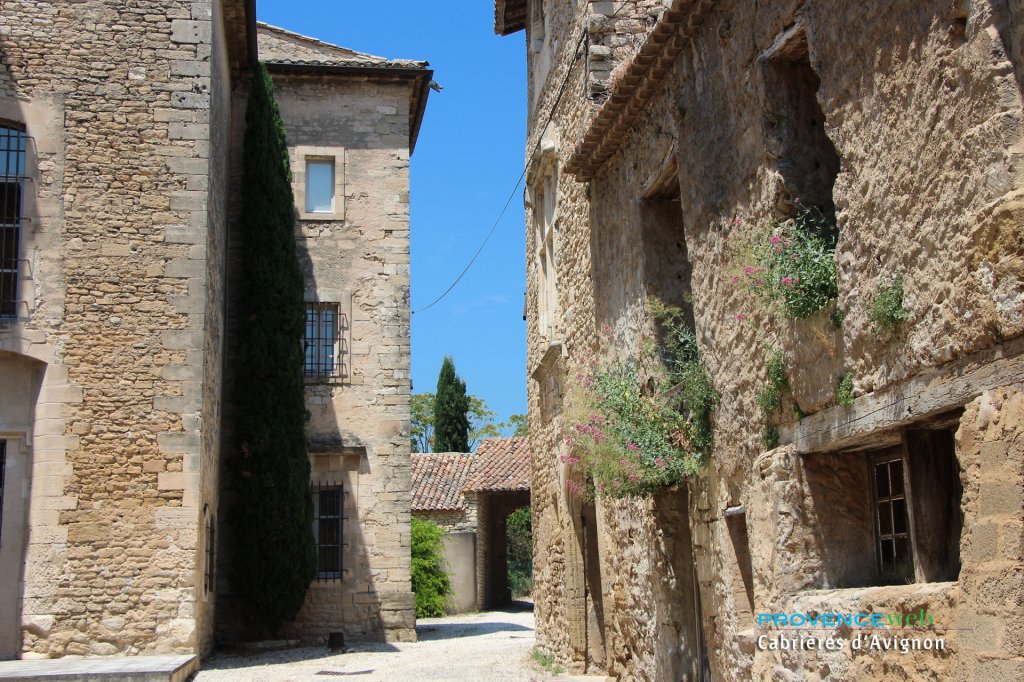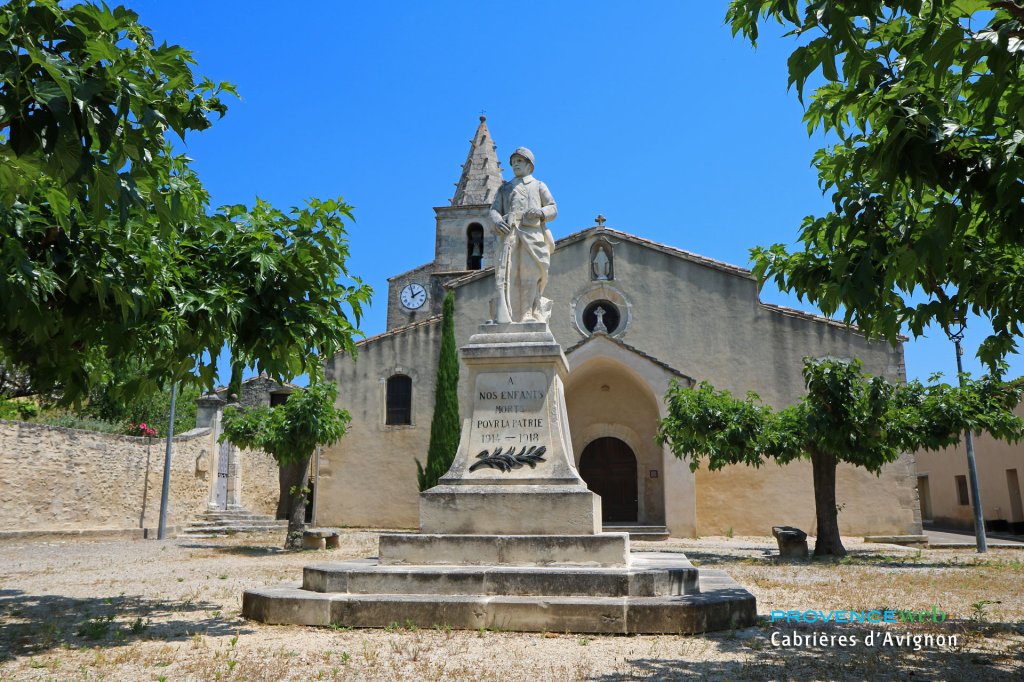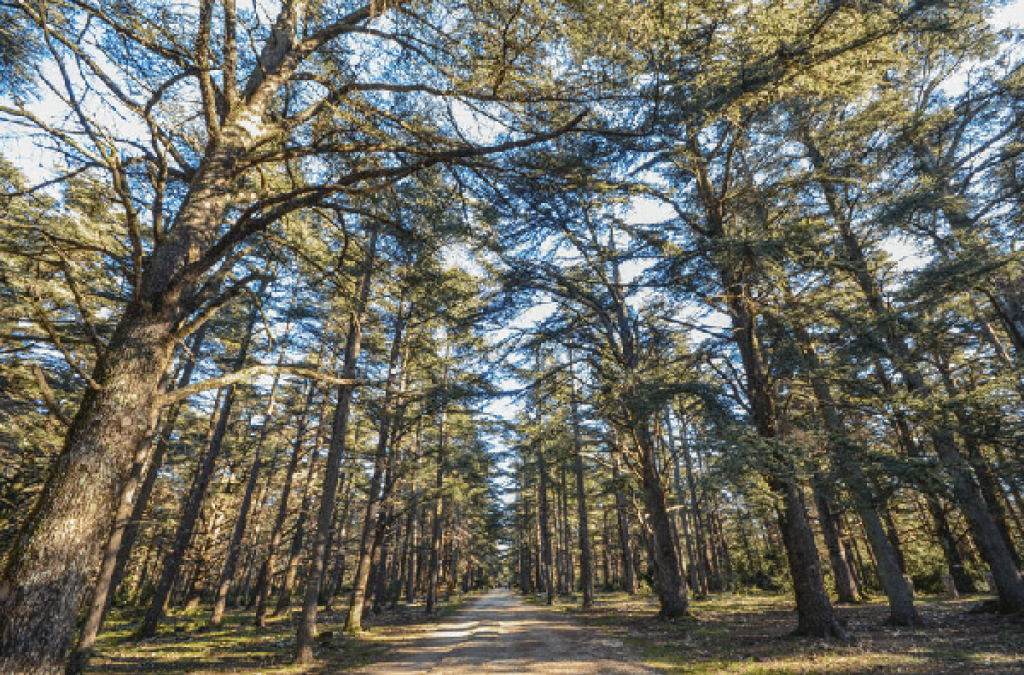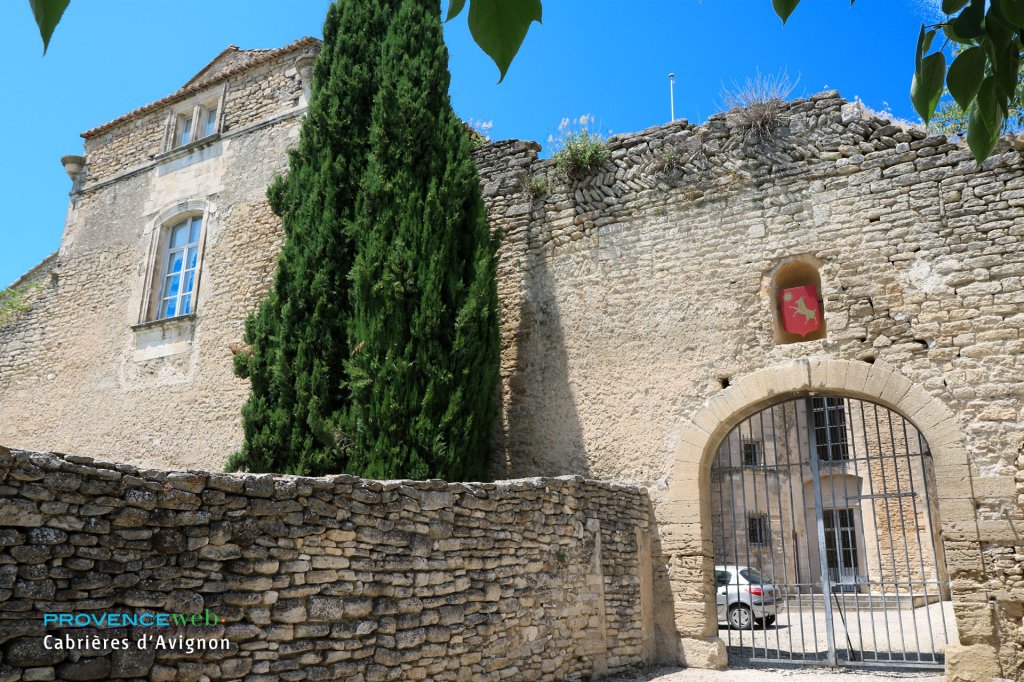Cabrières d'Avignon
Between Gordes and L'Isle sur la Sorgue.
Discover Cabrières-d'Avignon: a charming village between Luberon and Vaucluse
Looking for a Provençal village untouched by mass tourism? Cabrières-d'Avignon is located 27 kilometers from Avignon, nestled on the slopes of the Monts de Vaucluse. This village of around 1,835 inhabitants faces the Luberon mountain. It is located in the heart of the dry stone country, between Gordes and Isle-sur-la-Sorgue.

The village offers two distinct faces: the cultivated Provence of the plains (cherry, almond, and olive trees) and the dry Provence of the garrigue. You will discover beautifully restored old dry stone houses and fountains that are prettily lit at night. The castle dates back to the 12th century, although it has been rebuilt many times. Its interior remains private, but its façade is well worth a visit.

The Plague Wall, built in 1720 to protect the Comtat Venaissin from the epidemic that came from Marseille, still crosses the territory. A landscaped walk follows this dry stone wall for 6 kilometers between Cabrières and Lagnes.

As you stroll through the village, you will discover its old houses built of dry stone or tastefully restored with rustic plaster.

In the countryside surrounding the village, you will come across a few bories, a type of old peasant dwelling dating mostly from the 17th and 18th centuries. Some have been converted into sumptuous second homes.
Walks around the village
There is a lovely walk along the infamous Mur de la Peste (Plague Wall), built long ago to protect the inhabitants of the Comtat from the Great Plague of Marseille in 1720. From Cabrières, it will take you to the east of Méthamis.

You can also enjoy a magnificent 5-hectare forest of tall cedars planted in 1860. This forest offers shaded walks with picnic areas.

It offers shade and coolness on hot summer days and will delight lovers of beautiful nature. In the surrounding countryside, you will also find bories, typical 17th and 18th century peasant dwellings.
What to see
The Plague Wall (mur de la peste).
XIIIth Chateau.
Lavender Museum at Coustellet
Leisure activities
Hiking. 5 hectare cedar forest.
Cinema. Seasonal events.
Holiday rentals
Superb apartment in a quiet location in a beautiful Provençal building. Lovely pool, welcoming hosts, tasteful furnishings, superb garden. You will love your vacation in Cabrières d'Avignon!
Accomodations
Hotels.
Bed and breakfast.
Holiday rentals.
Your questions about the village of Cabrières d'Avignon.
You have sent us many inquiries about this charming village. Here are our answers to your most frequently asked questions.
What is there to do in Cabrières-d'Avignon?
- The Luberon Regional Nature Park welcomes Cabrières in the Monts de Vaucluse. The village offers activities for all tastes, from heritage to hiking. You can easily organize your stay from the center.
- The cedar forest covers 5 hectares to the north of the village. Planted in 1860, this forest offers pleasant shaded walks in summer. The site has a refreshment bar, picnic areas, and a fitness trail. The cedars can reach heights of 30 to 40 meters.
- The plague wall remains one of the most visited sites in Cabrières. This dry stone wall was built in 1721 to protect the Comtat Venaissin from the epidemic. An easy hike of about 6 kilometers and 2 hours follows the wall from the town hall parking lot. The route offers superb panoramic views of the Gordes plain and Mont Ventoux.
- The Saint-Eusèbe Chapel is located south of the village and can be reached by a family-friendly walk. This chapel dates from the 16th or 17th century and was probably built on the site of an ancient place of worship. The walk is about 2.5 kilometers round trip and crosses fields and vineyards. You will have a beautiful view of the Luberon and the Alpilles.
- The parish church of Saint-Vincent was consecrated in 1587. It replaces the original Romanesque church, which was razed after the events of 1545. This remarkable stone church serves as a focal point for village life. Its Provençal architecture is well worth a visit.
- The Château de Cabrières dates from the 11th or 12th century. It was rebuilt at the end of the 16th century after the massacre of the Vaudois. This private castle, listed as a historic monument, can only be visited during Heritage Days in September. Its façade dominates the village from the heights.
- Several hikes starting from Cabrières allow you to discover the region. The GR6 and GR97 long-distance hiking trails pass through the commune. The routes cross varied landscapes: olive groves, vineyards, hills, and forests. Nature tourism attracts many visitors every year.
What is the origin of the name Cabrières?
The origin of the name Cabrières can be found in the Occitan word cabrièra, which means stable or goat pen. The word comes from cabra (cabro in Mistralian spelling), which means goat. This etymology derives from the Latin capra. The village was therefore literally the land of goats.
The name was transcribed in 1180 as Cabrieras. It was then successively written as Capreris, caprieras, and then back to Cabrieras. The French name Cabrières appeared in the 16th century. The history of the village is reflected in these linguistic transformations.
Comtat or Avignon was then added because the village was located in the Comtat Venaissin. In 1918, Cabrières officially took the name Cabrières-d'Avignon. This change made it possible to differentiate it from Cabrières-d'Aigues, also located in the Vaucluse. This Provençal name is still in use today.
What are the historical attractions?
- The castle was built in the 11th or 12th century by the Adhémar family. This family of viscounts of Cavaillon became the Baux-Adhémar after an alliance. The castle served as a refuge for the Waldensians during Easter 1545. It was rebuilt at the end of the 16th century after its destruction.
- The plague wall originally stretched for 27 kilometers. It was about 2 meters high and built of dry stone. This rampart was built in 1721 on the decision of the people of Avignon to limit the spread of the disease. Today, 6 kilometers remain between Cabrières and Lagnes.
- The parish church of Saint-Vincent dates from the end of the 16th century. It was designed in the Romanesque style with a central nave and vaulted aisles. The square bell tower with a merlet spire replaced an existing arcade bell tower in 1597. Its architecture bears witness to the region's religious heritage.
- The Saint-Eusèbe Chapel was built in the 16th or 17th century. It probably stands on the site of an ancient place of worship. This medieval oratory is located in a peaceful natural setting. Processions were held there until 1914-1918.
- The medieval village of Cabrières was the only fortified Waldensian village in the region. In 1545, it served as a refuge during the persecution. The siege began on April 19 by troops under the command of President Maynier. The toll was 400 to 500 dead and the village was razed to the ground.
- A column commemorates the 1545 massacre in the village. Eustache Marron, leader of the Waldensian resistance in the 16th century, had made it his stronghold. He was executed in Avignon as an example. This dark history has had a profound impact on Cabrières' identity.
How to get to Cabrières-d'Avignon
Access is from Coustellet via the D110 road. Coming from Avignon, take the RN 100 then the departmental road 147. From Lagnes, take the departmental road 100. From Gordes, follow the D2 then the D110.
The town is served by the A7 motorway exits at Avignon Sud or Cavaillon. The nearest SNCF train station is in Cavaillon. The nearest TGV station is in Avignon. Traveling by car is still the most convenient way to visit the region.
Cabrières is located 27 kilometers from Avignon. The village is about 15 kilometers from Fontaine-de-Vaucluse. L'Isle-sur-la-Sorgue is located about 18 kilometers away. These distances make it possible to combine several visits in the same day.
What events are there in Cabrières-d'Avignon?
- The traditional Fête des Cèdres takes place on the first Sunday in May. The association Les Amis des Cèdres organizes this event on the Beauregard site. Musical entertainment and meals are provided. The proceeds go towards the maintenance and beautification of the site.
- The castle can only be visited during the European Heritage Days in September. This private castle, listed as a historic monument, opens its doors exceptionally for the occasion. Other private dry stone properties also take part in these days. It is a unique opportunity to discover this heritage, which is closed to the public the rest of the year.
- The association Les Amis du Patrimoine (Friends of Heritage) offers tours of the cedar forest. These activities showcase the species found in the Monts de Vaucluse and the history of the cedar forest. New signage has been put in place along the botanical trail. These activities provide an opportunity to learn more about the surrounding nature.
- Cultural tourism sets the pace of village life throughout the year. In July, the village festival is held on the Sunday closest to the 14th. Exhibitions and events regularly enliven the surrounding area. Provençal culture is very much alive in Cabrières.
Where to stay in Cabrières-d'Avignon?
- Bed and breakfasts offer a family welcome in Provençal farmhouses. Rates start at €130 per night for two people, including breakfast. Several establishments have a swimming pool open from early May to early October.
- Independent cottages can accommodate 2 to 8 people. Weekly rates start at around $800 depending on the season. Some cottages are Gîtes de France certified. These accommodations are often located in the countryside with views of the Luberon.
- Seasonal rentals generally include Wi-Fi, a fully equipped kitchen, and terraces. Facing the Luberon, at the foot of Gordes, these family farmhouses are the symbol of Provence. Some properties accept pets on request. Comfort is combined with the authenticity of old stone buildings.
What is the population of Cabrières-d'Avignon?
The official legal population of Cabrières is 1,795 inhabitants. However, this figure dates from 2021 according to the latest INSEE data. The municipality covers 14.7 square kilometers.










NEIGHBOURING TOWNS AND VILLAGES
Lagnes (4 km), St Pantaléon (6 km), Gordes (7 km) and L'Isle sur la Sorgue (13 km).


